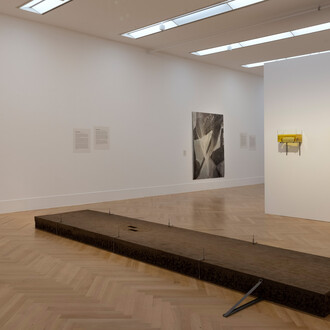Martin Kippenberger (1953–1997) was one of the most versatile, productive and influential German artists of his generation. Like no other, he embodies the image of the ‘typical artist’. Like no other, he lived an indiscerptible symbiosis of life and artistic production – intensively and excessively, with all personal consequences. All his works are self-portraits in the broadest sense: They say something about him and his environment – even those that do not depict an actual image of him. His work is complex and is based on permanent self-questioning, whereby he does not shy away from breaks or even outright failure.
I want to have an influence on how these times are debated.
(Martin Kippenberger)
His activities included acting, performing, making exhibitions, organising and writing. His rich œuvre comprises music, photographs, drawings, posters, collages, multiples, editions, artist’s books, paintings, sculptures and large-scale installations. His instinct for his own public image was just as important a working strategy as his well-functioning network.
His art appropriates, quotes and deconstructs before it constructs something new. Kippenberger’s work is based on a good knowledge of cultural and contemporary history and a keen observation of everyday life. He constantly picked up on topical issues from society, politics and (pop) culture and consistently reflected on themes and traditions in the visual arts. The diversity of his work, the axiomatic, seemingly arbitrary, unconventional and humorous playing with forms and contents place him in a Dadaist tradition – one need only think of Kurt Schwitters with his Ursonate and his parodic treatment of language.
And I’m working to ensure that people can say: Kippenberger was in a good mood!
(Autor)
Kippenberger’s artistic gestures only ostensibly reflect a careless dilettantism, which he used in a well thought out and strategic manner. His work is characterised by exuberant creativity, great empathy and diversity with regard to content and form.
He was a master of sounding out and piecing together and combined, for example, banal motifs such as an egg with philosophical references – irritations, provocations, curiosity and passion characterise his work. His intuitive intelligence open up many, at times controversial possibilities of interpretation: It demands that the work be examined as a whole, as a network.
In his changing roles, Kippenberger created and transformed himself as an artist and questioned concepts of identification and authorship. He thus, for example, commissioned a poster painter to create a series of works titled Lieber Maler, male mir (Dear Painter, Paint for Me), which was unusual and by all means outside the norm.
He makes pointed use of language and thus intensifies the narrative components of his works. His titles generally provide the key to the themes, and the exhibition thus quotes the title of one of his works, perfectly illustrating Martin Kippenberger’s attitude of a permanent give and take, of input and output.
The exhibition itself reflects his extraordinary productivity, presenting works from all creative periods and most media, and thus opens the reception and discussion for the present times.
















